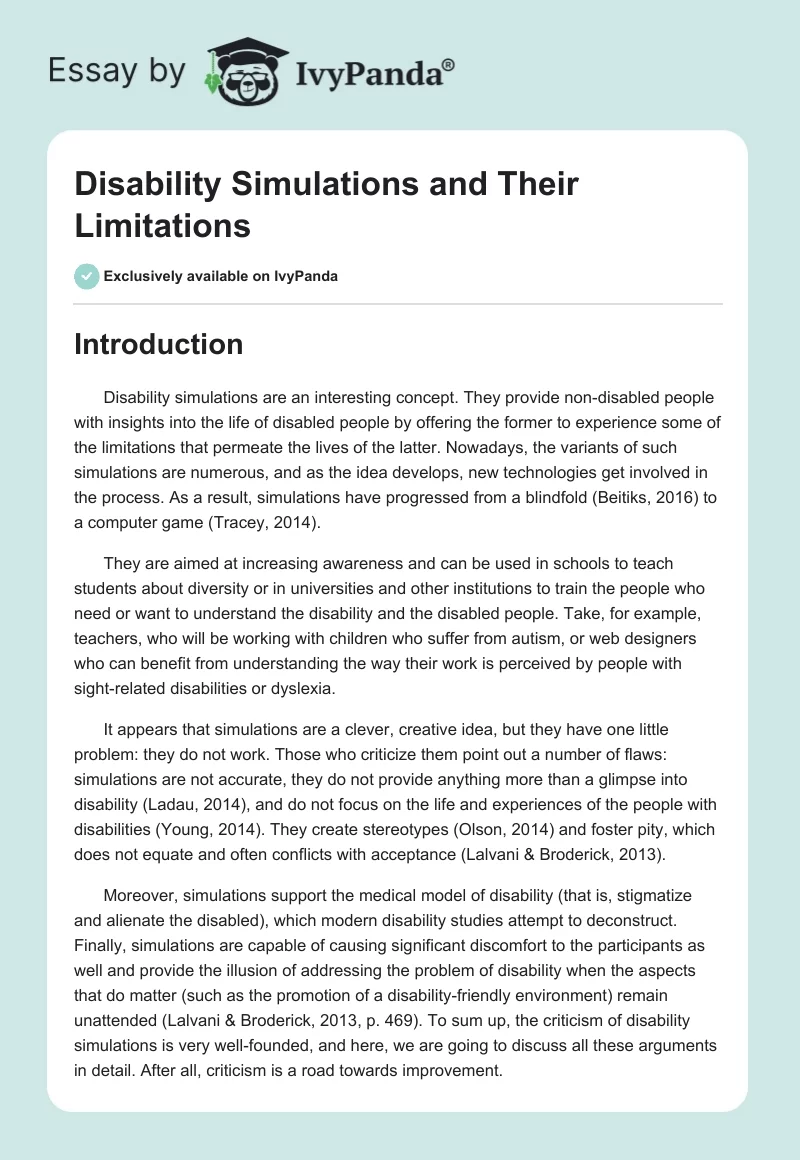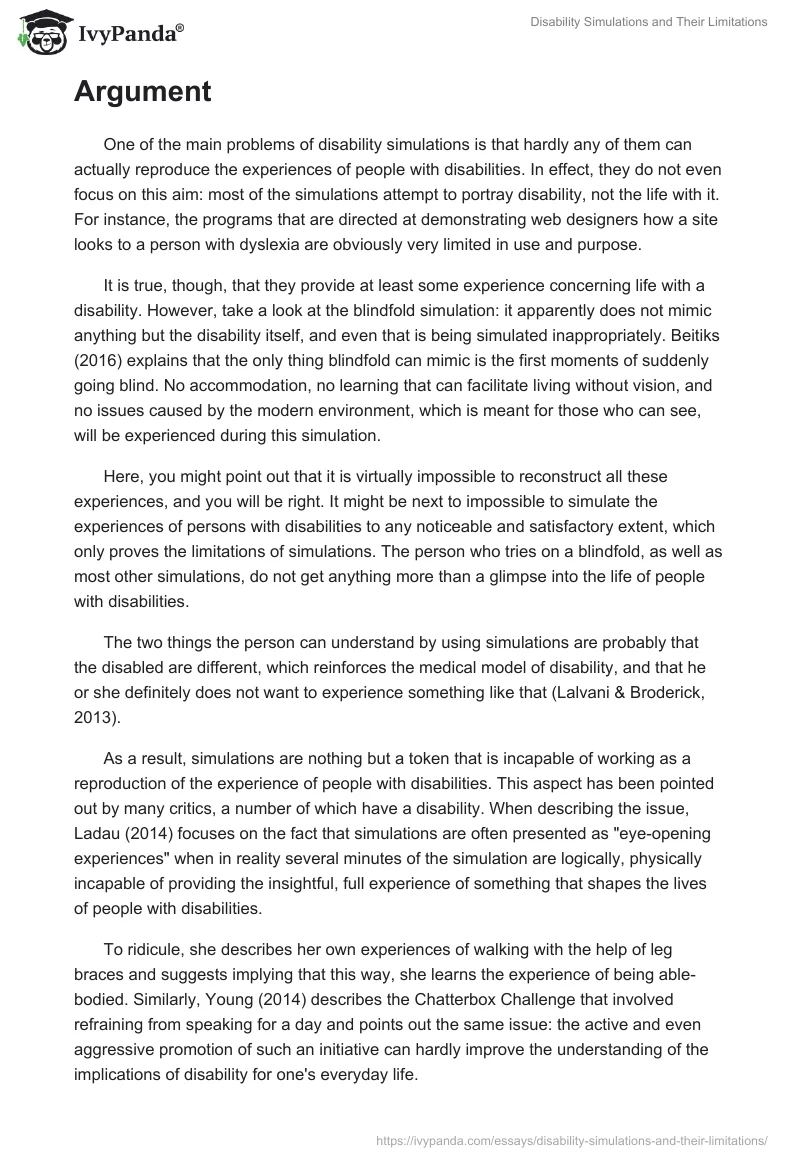Introduction
Disability simulations are an interesting concept. They provide non-disabled people with insights into the life of disabled people by offering the former to experience some of the limitations that permeate the lives of the latter. Nowadays, the variants of such simulations are numerous, and as the idea develops, new technologies get involved in the process. As a result, simulations have progressed from a blindfold (Beitiks, 2016) to a computer game (Tracey, 2014).
They are aimed at increasing awareness and can be used in schools to teach students about diversity or in universities and other institutions to train the people who need or want to understand the disability and the disabled people. Take, for example, teachers, who will be working with children who suffer from autism, or web designers who can benefit from understanding the way their work is perceived by people with sight-related disabilities or dyslexia.
It appears that simulations are a clever, creative idea, but they have one little problem: they do not work. Those who criticize them point out a number of flaws: simulations are not accurate, they do not provide anything more than a glimpse into disability (Ladau, 2014), and do not focus on the life and experiences of the people with disabilities (Young, 2014). They create stereotypes (Olson, 2014) and foster pity, which does not equate and often conflicts with acceptance (Lalvani & Broderick, 2013).
Moreover, simulations support the medical model of disability (that is, stigmatize and alienate the disabled), which modern disability studies attempt to deconstruct. Finally, simulations are capable of causing significant discomfort to the participants as well and provide the illusion of addressing the problem of disability when the aspects that do matter (such as the promotion of a disability-friendly environment) remain unattended (Lalvani & Broderick, 2013, p. 469). To sum up, the criticism of disability simulations is very well-founded, and here, we are going to discuss all these arguments in detail. After all, criticism is a road towards improvement.
Argument
One of the main problems of disability simulations is that hardly any of them can actually reproduce the experiences of people with disabilities. In effect, they do not even focus on this aim: most of the simulations attempt to portray disability, not the life with it. For instance, the programs that are directed at demonstrating web designers how a site looks to a person with dyslexia are obviously very limited in use and purpose.
It is true, though, that they provide at least some experience concerning life with a disability. However, take a look at the blindfold simulation: it apparently does not mimic anything but the disability itself, and even that is being simulated inappropriately. Beitiks (2016) explains that the only thing blindfold can mimic is the first moments of suddenly going blind. No accommodation, no learning that can facilitate living without vision, and no issues caused by the modern environment, which is meant for those who can see, will be experienced during this simulation.
Here, you might point out that it is virtually impossible to reconstruct all these experiences, and you will be right. It might be next to impossible to simulate the experiences of persons with disabilities to any noticeable and satisfactory extent, which only proves the limitations of simulations. The person who tries on a blindfold, as well as most other simulations, do not get anything more than a glimpse into the life of people with disabilities.
The two things the person can understand by using simulations are probably that the disabled are different, which reinforces the medical model of disability, and that he or she definitely does not want to experience something like that (Lalvani & Broderick, 2013).
As a result, simulations are nothing but a token that is incapable of working as a reproduction of the experience of people with disabilities. This aspect has been pointed out by many critics, a number of which have a disability. When describing the issue, Ladau (2014) focuses on the fact that simulations are often presented as “eye-opening experiences” when in reality several minutes of the simulation are logically, physically incapable of providing the insightful, full experience of something that shapes the lives of people with disabilities.
To ridicule, she describes her own experiences of walking with the help of leg braces and suggests implying that this way, she learns the experience of being able-bodied. Similarly, Young (2014) describes the Chatterbox Challenge that involved refraining from speaking for a day and points out the same issue: the active and even aggressive promotion of such an initiative can hardly improve the understanding of the implications of disability for one’s everyday life.
Perhaps the problem of not being able to provide a proper insight into the lives of persons with disabilities is not a crucial flaw if the simulation can serve another purpose. After all, people who come up with simulations do show an exceptional amount of creativity in achieving practical aims. However, this aspect should impose significant limitations on the claims of the developers, users, and promoters (especially promoters). Surprisingly, such limitations are not typically discussed.
References
Beitiks, E. (2016). Teaching the Sighted about Blindness in a Way that Doesn’t Suck (Leave your Blindfolds at Home!). [Blog post]. Web.
Ladau, E. (2014). I Won’t Pretend That Disability Simulation Works. Huffington Post. Web.
Lalvani, P. & Broderick, A. (2013). Institutionalized Ableism and the Misguided “Disability Awareness Day”: Transformative Pedagogies for Teacher Education. Equity & Excellence In Education, 46(4), 468-483. Web.
Olson, T. (2014). How Disability Simulations Promote Damaging Stereotypes. The Braille Monitor. [Blog post]. Web.
Tracey, E. (2014). Not just a game: Is it right to ‘recreate’ disability?BBC News, Ouch. Web.
Young, S. (2014). Disability simulations should be left in the 90s. The Drum ABC. Web.


